目录
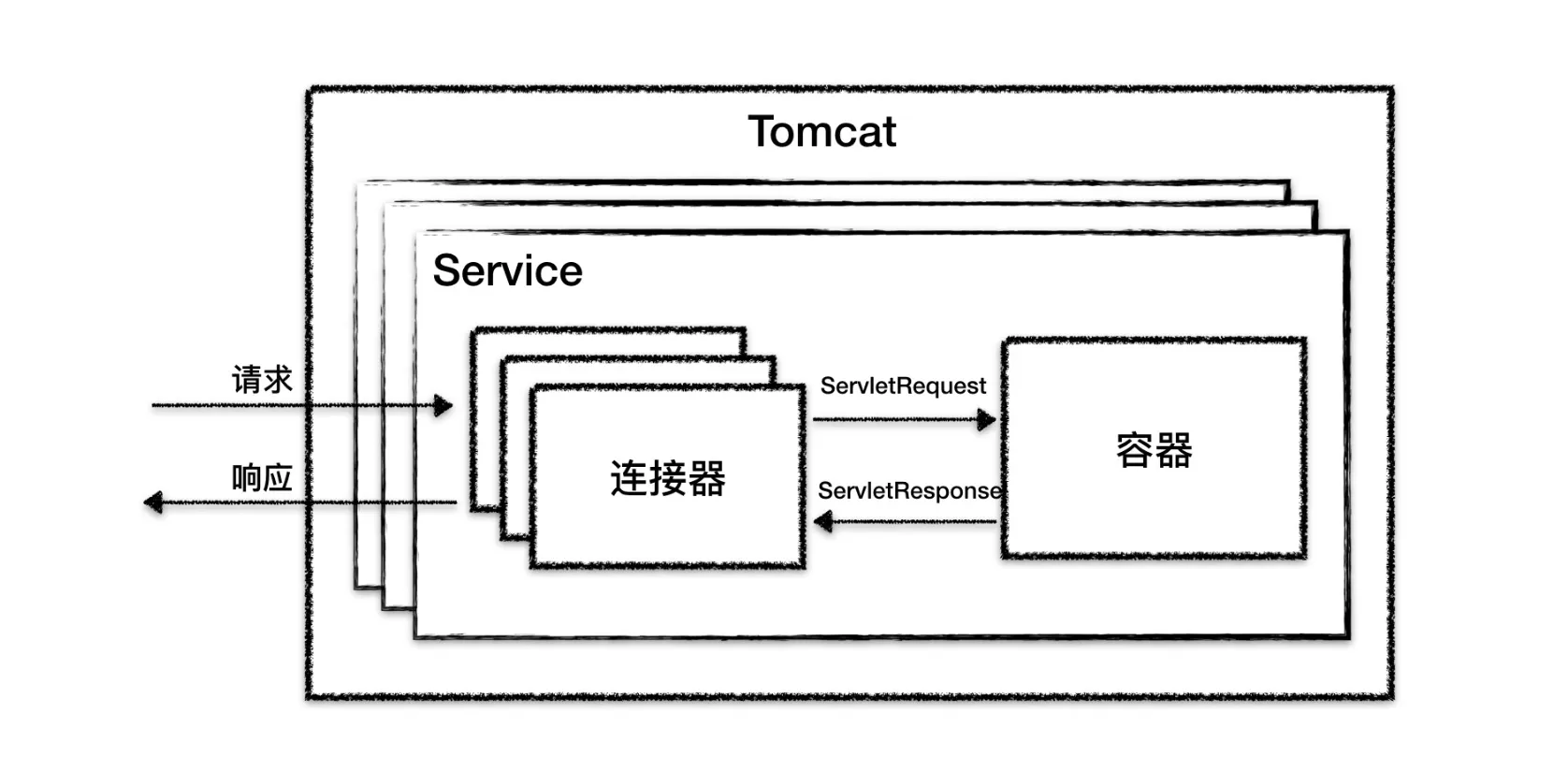
容器的层次结构
Tomcat 设计了 4 种容器,分别是 Engine、Host、Context 和 Wrapper。这 4 种容器不是平行关系,而是父子关系。
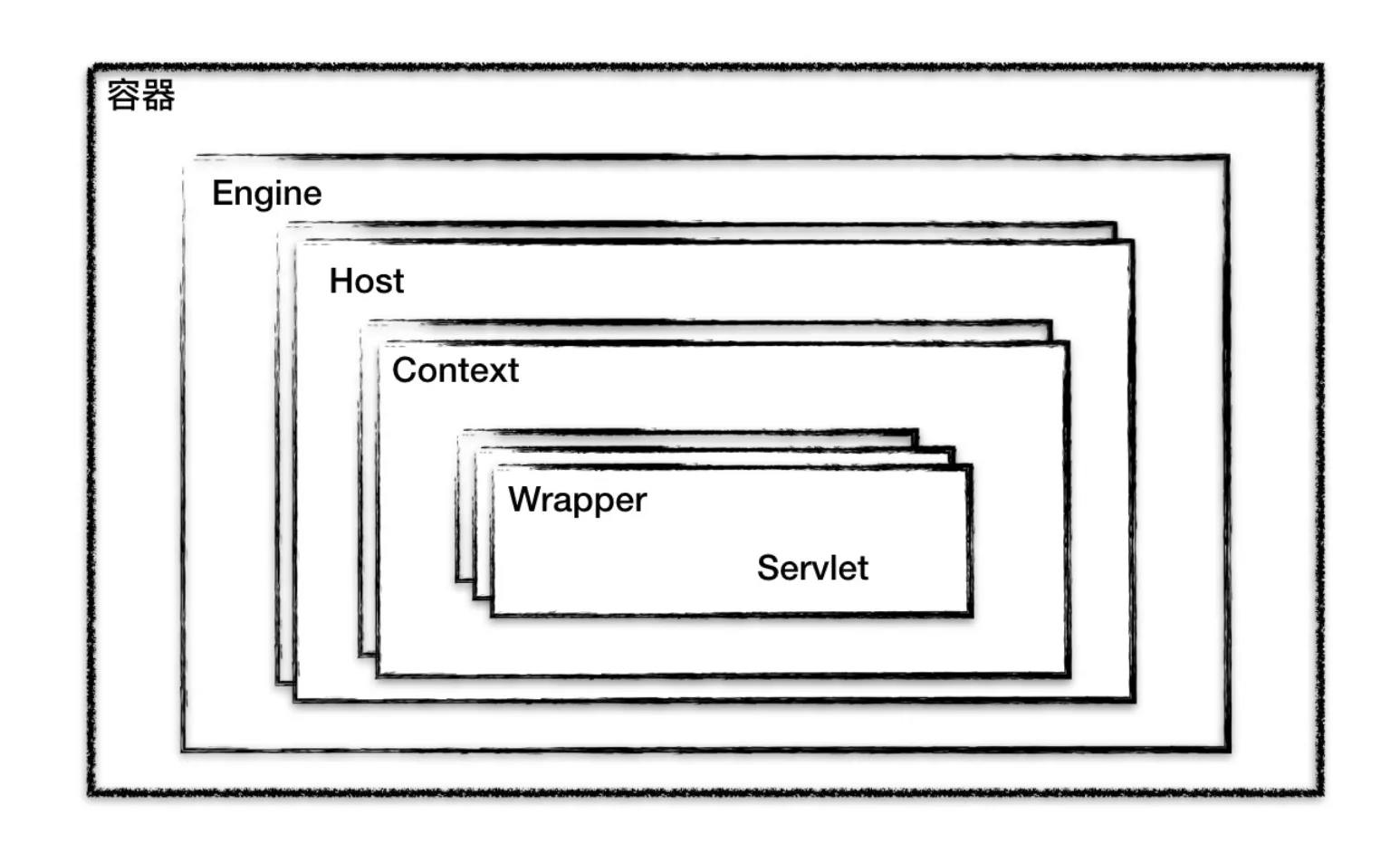
你可以再通过 Tomcat 的 server.xml 配置文件来加深对 Tomcat 容器的理解。Tomcat 采用了组件化的设计,它的构成组件都是可配置的,其中最外层的是 Server,其他组件按照一定的格式要求配置在这个顶层容器中。
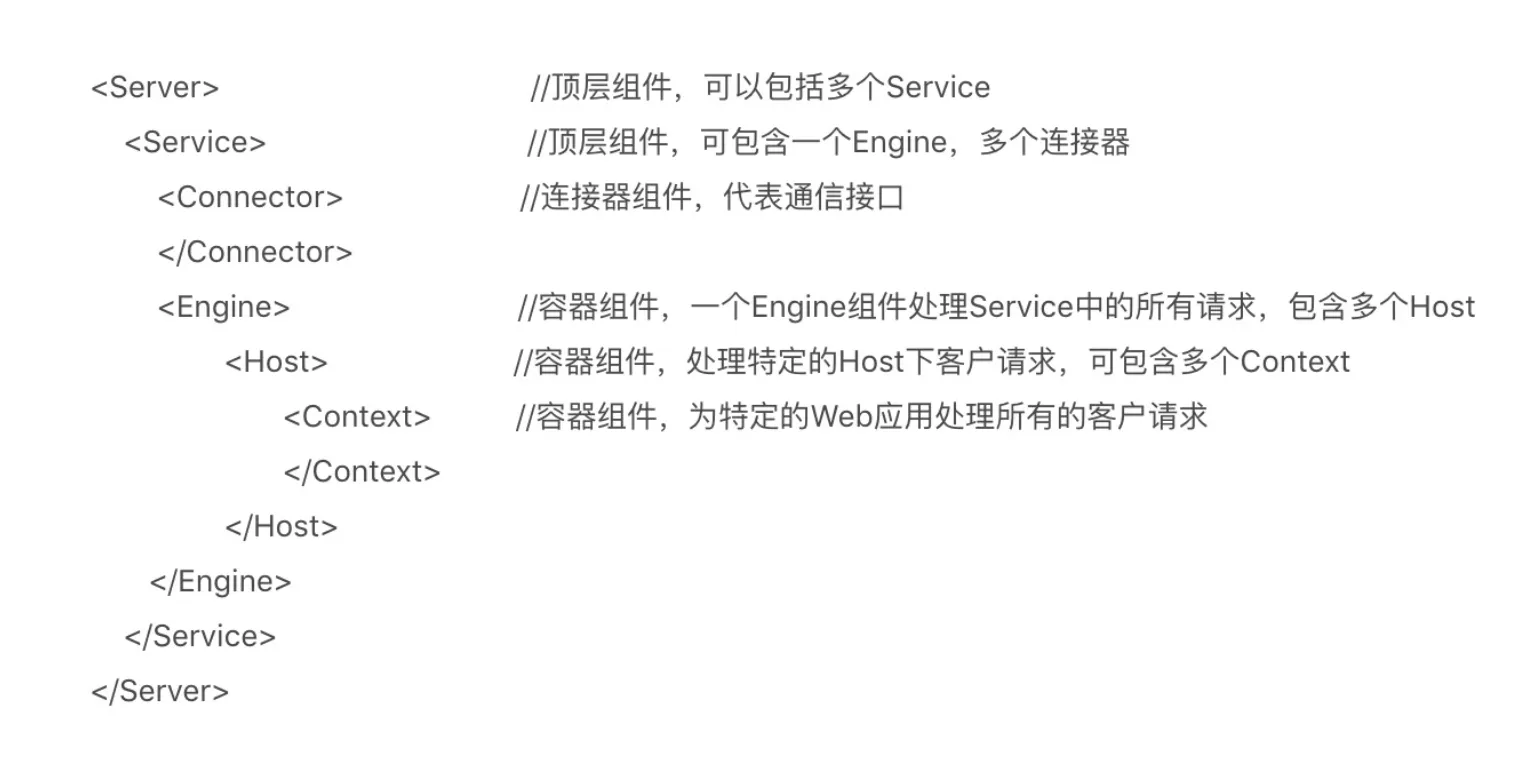
Container接口
cpppublic interface Container extends Lifecycle {
public void setName(String name);
public Container getParent();
public void setParent(Container container);
public void addChild(Container child);
public void removeChild(Container child);
public Container findChild(String name);
}
所有容器组件都实现了 Container 接口,因此组合模式可以使得用户对单容器对象和组合容器对象的使用具有一致性。这里单容器对象指的是最底层的 Wrapper,组合容器对象指的是上面的 Context、Host 或者 Engine。Container 接口定义如下:
Mapper 组件的功能就是将用户请求的 URL 定位到一个 Servlet,它的工作原理是:Mapper 组件里保存了 Web 应用的配置信息,其实就是容器组件与访问路径的映射关系,比如 Host 容器里配置的域名、Context 容器里的 Web 应用路径,以及 Wrapper 容器里 Servlet 映射的路径,你可以想象这些配置信息就是一个多层次的 Map。
当一个请求到来时,Mapper 组件通过解析请求 URL 里的域名和路径,再到自己保存的 Map 里去查找,就能定位到一个 Servlet。请你注意,一个请求 URL 最后只会定位到一个 Wrapper 容器,也就是一个 Servlet。
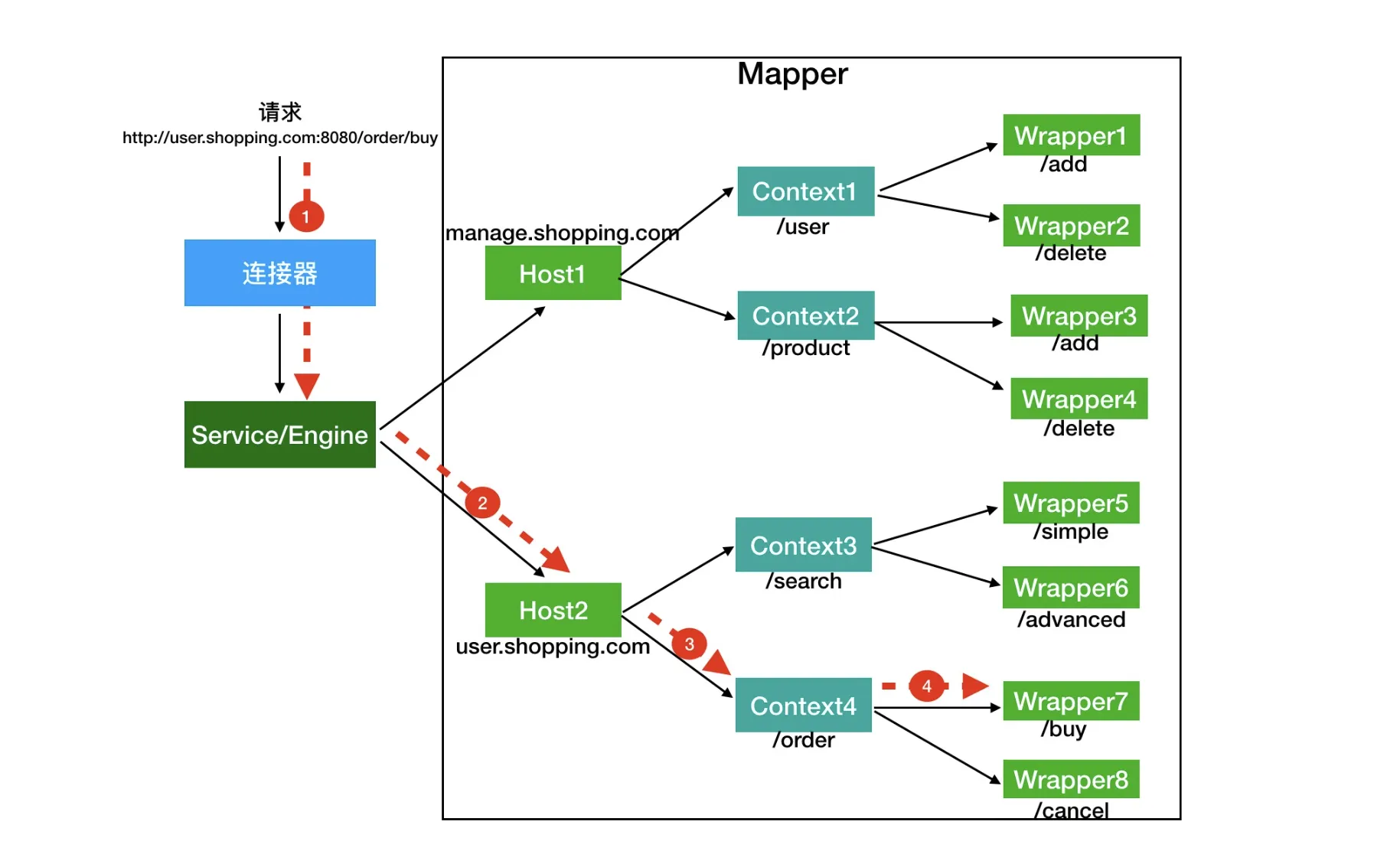
并不是说只有 Servlet 才会去处理请求,实际上这个查找路径上的父子容器都会对请求做一些处理。我在上一期说过,连接器中的 Adapter 会调用容器的 Service 方法来执行 Servlet,最先拿到请求的是 Engine 容器,Engine 容器对请求做一些处理后,会把请求传给自己子容器 Host 继续处理,依次类推,最后这个请求会传给 Wrapper 容器,Wrapper 会调用最终的 Servlet 来处理。
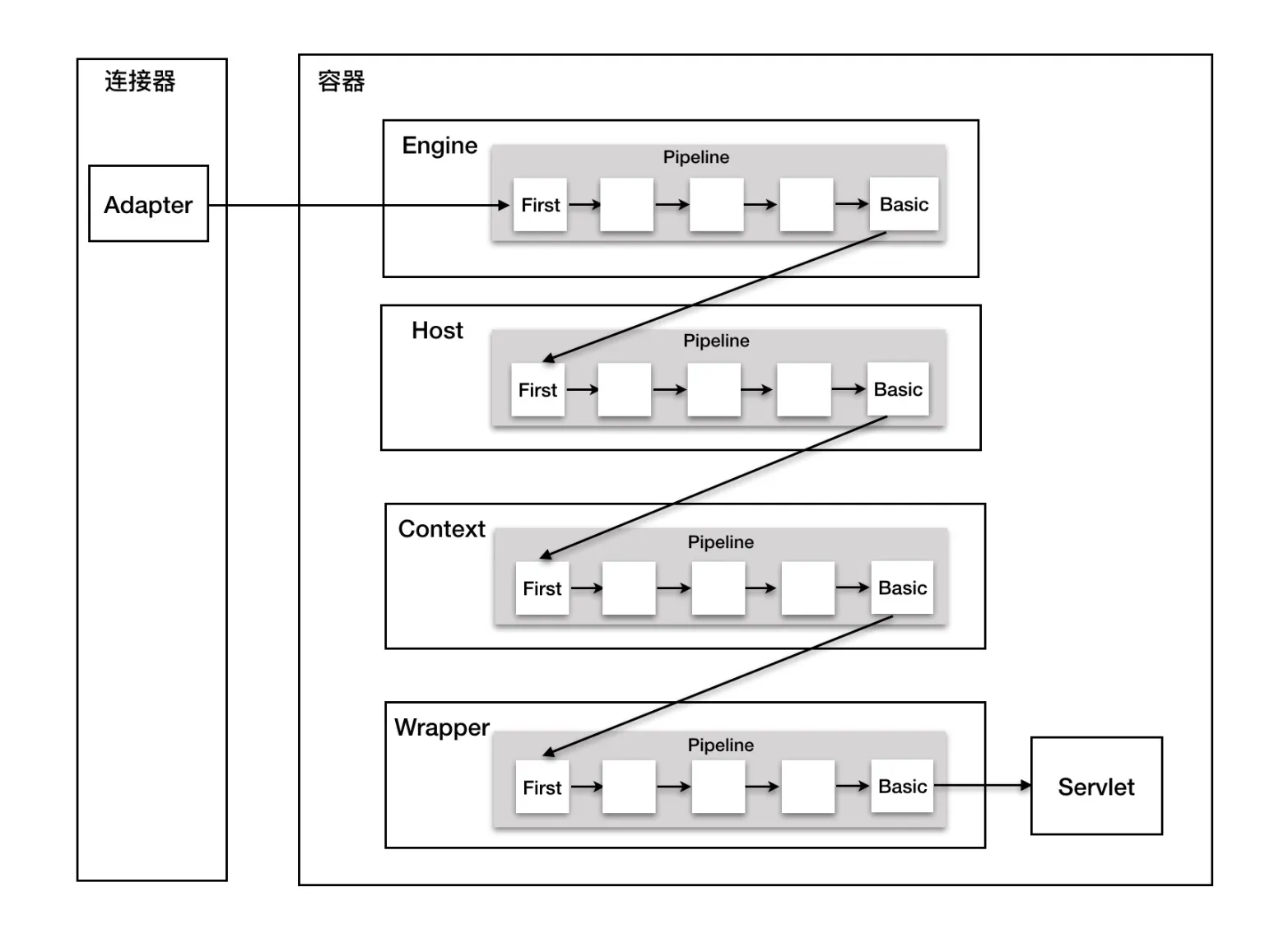
Wrapper 容器的最后一个 Valve 会创建一个 Filter 链,并调用 doFilter() 方法,最终会调到 Servlet 的 service 方法。
Filter和Value区别
Valve 是 Tomcat 的私有机制,与 Tomcat 的基础架构 /API 是紧耦合的。Servlet API 是公有的标准,所有的 Web 容器包括 Jetty 都支持 Filter 机制。
另一个重要的区别是 Valve 工作在 Web 容器级别,拦截所有应用的请求;而 Servlet Filter 工作在应用级别,只能拦截某个 Web 应用的所有请求。如果想做整个 Web 容器的拦截器,必须通过 Valve 来实现。
一个初始的server.xml
xml<?xml version="1.0" encoding="UTF-8"?>
<!--
Licensed to the Apache Software Foundation (ASF) under one or more
contributor license agreements. See the NOTICE file distributed with
this work for additional information regarding copyright ownership.
The ASF licenses this file to You under the Apache License, Version 2.0
(the "License"); you may not use this file except in compliance with
the License. You may obtain a copy of the License at
http://www.apache.org/licenses/LICENSE-2.0
Unless required by applicable law or agreed to in writing, software
distributed under the License is distributed on an "AS IS" BASIS,
WITHOUT WARRANTIES OR CONDITIONS OF ANY KIND, either express or implied.
See the License for the specific language governing permissions and
limitations under the License.
-->
<!-- Note: A "Server" is not itself a "Container", so you may not
define subcomponents such as "Valves" at this level.
Documentation at /docs/config/server.html
-->
<Server port="8005" shutdown="SHUTDOWN">
<Listener className="org.apache.catalina.startup.VersionLoggerListener" />
<!-- Security listener. Documentation at /docs/config/listeners.html
<Listener className="org.apache.catalina.security.SecurityListener" />
-->
<!-- APR library loader. Documentation at /docs/apr.html -->
<Listener className="org.apache.catalina.core.AprLifecycleListener" SSLEngine="on" />
<!-- Prevent memory leaks due to use of particular java/javax APIs-->
<Listener className="org.apache.catalina.core.JreMemoryLeakPreventionListener" />
<Listener className="org.apache.catalina.mbeans.GlobalResourcesLifecycleListener" />
<Listener className="org.apache.catalina.core.ThreadLocalLeakPreventionListener" />
<!-- Global JNDI resources
Documentation at /docs/jndi-resources-howto.html
-->
<GlobalNamingResources>
<!-- Editable user database that can also be used by
UserDatabaseRealm to authenticate users
-->
<Resource name="UserDatabase" auth="Container"
type="org.apache.catalina.UserDatabase"
description="User database that can be updated and saved"
factory="org.apache.catalina.users.MemoryUserDatabaseFactory"
pathname="conf/tomcat-users.xml" />
</GlobalNamingResources>
<!-- A "Service" is a collection of one or more "Connectors" that share
a single "Container" Note: A "Service" is not itself a "Container",
so you may not define subcomponents such as "Valves" at this level.
Documentation at /docs/config/service.html
-->
<Service name="Catalina">
<!--The connectors can use a shared executor, you can define one or more named thread pools-->
<!--
<Executor name="tomcatThreadPool" namePrefix="catalina-exec-"
maxThreads="150" minSpareThreads="4"/>
-->
<!-- A "Connector" represents an endpoint by which requests are received
and responses are returned. Documentation at :
HTTP Connector: /docs/config/http.html
AJP Connector: /docs/config/ajp.html
Define a non-SSL/TLS HTTP/1.1 Connector on port 8080
-->
<Connector port="8080" protocol="HTTP/1.1"
connectionTimeout="20000"
redirectPort="8443"
maxParameterCount="1000"
/>
<!-- A "Connector" using the shared thread pool-->
<!--
<Connector executor="tomcatThreadPool"
port="8080" protocol="HTTP/1.1"
connectionTimeout="20000"
redirectPort="8443"
maxParameterCount="1000"
/>
-->
<!-- Define an SSL/TLS HTTP/1.1 Connector on port 8443 with HTTP/2
This connector uses the NIO implementation. The default
SSLImplementation will depend on the presence of the APR/native
library and the useOpenSSL attribute of the AprLifecycleListener.
Either JSSE or OpenSSL style configuration may be used regardless of
the SSLImplementation selected. JSSE style configuration is used below.
-->
<!--
<Connector port="8443" protocol="org.apache.coyote.http11.Http11NioProtocol"
maxThreads="150" SSLEnabled="true"
maxParameterCount="1000"
>
<UpgradeProtocol className="org.apache.coyote.http2.Http2Protocol" />
<SSLHostConfig>
<Certificate certificateKeystoreFile="conf/localhost-rsa.jks"
type="RSA" />
</SSLHostConfig>
</Connector>
-->
<!-- Define an AJP 1.3 Connector on port 8009 -->
<!--
<Connector protocol="AJP/1.3"
address="::1"
port="8009"
redirectPort="8443"
maxParameterCount="1000"
/>
-->
<!-- An Engine represents the entry point (within Catalina) that processes
every request. The Engine implementation for Tomcat stand alone
analyzes the HTTP headers included with the request, and passes them
on to the appropriate Host (virtual host).
Documentation at /docs/config/engine.html -->
<!-- You should set jvmRoute to support load-balancing via AJP ie :
<Engine name="Catalina" defaultHost="localhost" jvmRoute="jvm1">
-->
<Engine name="Catalina" defaultHost="localhost">
<!--For clustering, please take a look at documentation at:
/docs/cluster-howto.html (simple how to)
/docs/config/cluster.html (reference documentation) -->
<!--
<Cluster className="org.apache.catalina.ha.tcp.SimpleTcpCluster"/>
-->
<!-- Use the LockOutRealm to prevent attempts to guess user passwords
via a brute-force attack -->
<Realm className="org.apache.catalina.realm.LockOutRealm">
<!-- This Realm uses the UserDatabase configured in the global JNDI
resources under the key "UserDatabase". Any edits
that are performed against this UserDatabase are immediately
available for use by the Realm. -->
<Realm className="org.apache.catalina.realm.UserDatabaseRealm"
resourceName="UserDatabase"/>
</Realm>
<Host name="localhost" appBase="webapps"
unpackWARs="true" autoDeploy="true">
<!-- SingleSignOn valve, share authentication between web applications
Documentation at: /docs/config/valve.html -->
<!--
<Valve className="org.apache.catalina.authenticator.SingleSignOn" />
-->
<!-- Access log processes all example.
Documentation at: /docs/config/valve.html
Note: The pattern used is equivalent to using pattern="common" -->
<Valve className="org.apache.catalina.valves.AccessLogValve" directory="logs"
prefix="localhost_access_log" suffix=".txt"
pattern="%h %l %u %t "%r" %s %b" />
</Host>
</Engine>
</Service>
</Server>
本文作者:yowayimono
本文链接:
版权声明:本博客所有文章除特别声明外,均采用 BY-NC-SA 许可协议。转载请注明出处!